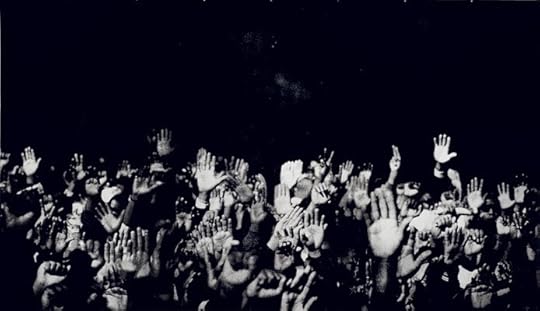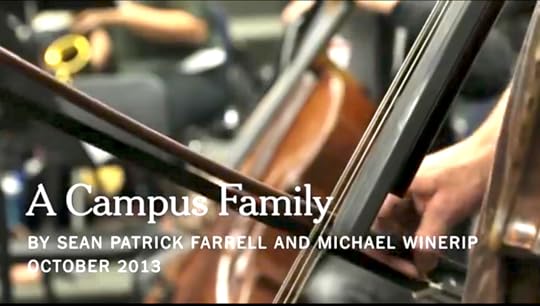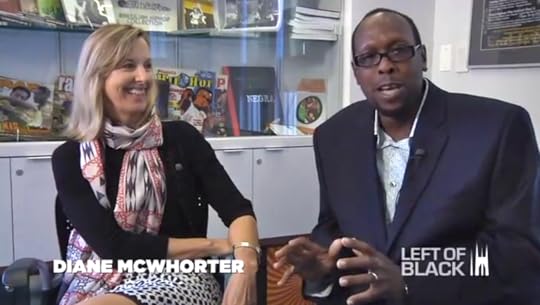Mark Anthony Neal's Blog, page 858
November 2, 2013
'Start Up' TV Profiles Brooklyn's Akwaaba Mansion B&B
 Start Up TV
Start Up TVSTART UP is a television program that offers its viewers an up-close and personal look into the world of the modern American entrepreneur.
Akwaaba Bed & Breakfast Inns is the upscale lodging collection owned by husband and wife team Glenn Pogue and Monique Greenwood.
Published on November 02, 2013 09:18
November 1, 2013
Producer 9th Wonder & Mark Anthony Neal to Teach the 'History of Hip-Hop' @ Duke University in the Spring of 2014

The History of Hip-HopSPRING 2014Duke University
Tuesday 6:15-08:45 pmWhite Lecture Hall 107AAAS 335.01CulAnth 335.01Music 335.01VMS 335.01
9thWonder (Patrick Douthit)—@9thWonderMusicMark Anthony Neal, Ph.D.—@NewBlackMan
What began as a localized activity designed to provide a safe haven for Black and Latino youth in New York City, has become a global brand with a documented impact on the cultural, political and economic realities of youth throughout the globe. This course will examine the organic social and cultural foundations of Hip-Hop Culture, as well as the key aesthetic innovators/innovations, and the debates that have arisen over Hip-hop’s increased influence.
TEXTS
That’s the Joint!: The Hip-Hop Studies Reader —ed. Murray Forman & Mark Anthony Neal
The Big Payback: The History of the Business of Hip-Hop —Don Charnas
Born to Use Mics: Reading Nas’ Illmatic —ed. Michael Eric Dyson & Sohail Daulatzai
And it Don’t Stop: The Best American Hip-Hop Journalism of the Last 25 Years —ed. Raquel Cepeda
Can't Stop Won't Stop: A History of the Hip-Hop Generation —Jeff Chang
Why White Kids Love Hip Hop: Wankstas, Wiggers, Wannabes, and the New Reality ofRace in America —Bakari Kitwana
Ego Trip's Book of Rap Lists –Sacha Jenkins; Elliott Wilson; Jeff Mao; Gabe Alvarez; Brent Rollins
Published on November 01, 2013 16:51
Producer 9th Wonder & Mark Anthony Neal Offer the 'History of Hip-Hop' @ Duke University in the Spring of 2014

The History of Hip-HopSPRING 2014Duke University
Tuesday 6:15-08:45 pmWhite Lecture Hall 107AAAS 335.01CulAnth 335.01Music 335.01VMS 335.01
9thWonder (Patrick Douthit)—@9thWonderMusicMark Anthony Neal, Ph.D.—@NewBlackMan
What began as a localized activity designed to provide a safe haven for Black and Latino youth in New York City, has become a global brand with a documented impact on the cultural, political and economic realities of youth throughout the globe. This course will examine the organic social and cultural foundations of Hip-Hop Culture, as well as the key aesthetic innovators/innovations, and the debates that have arisen over Hip-hop’s increased influence.
TEXTS
That’s the Joint!: The Hip-Hop Studies Reader —ed. Murray Forman & Mark Anthony Neal
The Big Payback: The History of the Business of Hip-Hop —Don Charnas
Born to Use Mics: Reading Nas’ Illmatic —ed. Michael Eric Dyson & Sohail Daulatzai
And it Don’t Stop: The Best American Hip-Hop Journalism of the Last 25 Years —ed. Raquel Cepeda
Can't Stop Won't Stop: A History of the Hip-Hop Generation —Jeff Chang
Why White Kids Love Hip Hop: Wankstas, Wiggers, Wannabes, and the New Reality ofRace in America —Bakari Kitwana
Ego Trip's Book of Rap Lists –Sacha Jenkins; Elliott Wilson; Jeff Mao; Gabe Alvarez; Brent Rollins
Published on November 01, 2013 16:51
Inhabitation: On Writing Black Death By John Murillo III
 Glenn Ligon (b. 1960), Hands, 1996. Silkscreen ink and gesso on unstretched canvas. 82 × 144 in. (208.3 × 365.8 cm). Collection of Eileen Harris Norton © Glenn Ligon; photograph by Fredrik NilsenAdrift
Glenn Ligon (b. 1960), Hands, 1996. Silkscreen ink and gesso on unstretched canvas. 82 × 144 in. (208.3 × 365.8 cm). Collection of Eileen Harris Norton © Glenn Ligon; photograph by Fredrik NilsenAdriftI think of M. NourbeSe Philip’s poetry, of writing that casts me adrift. Hapless/Helpless, and yet willing, I tumble in the vertigo gifted me by the waves and currents of the oceanic dark. Waters blackened by the blackness of breaks and breaking. Waters filled with the black blood of personal and collective trauma—the blood drawn siphoned from black existence to satiate the insatiable and vampiric hunger of the antiblack world—made all the blacker with the darkness of absence—blank spaces, blind spots, refusals (to recognize, write, believe the fact of unimaginable trauma), erasures, and the unspeakable, unnamable black holes around which these words spiral. I—
Reframe: I write in and from the vast expanse of the darkness. The declivity known as, or that marks an element of, “the zone of nonbeing” to which blacks were/are cast. An ontological space, a space of ontological absence; a psychic space, a space of psychic shatter; a material space, a place of wounds and torn flesh—I spin and tumble in the vertigo, here, adrift in the pain and the dark. I write from the place where blackness is, where it was brutally cast, splayed, broken, murdered. I write from the only place from which “an authentic upheaval can be born,” adrift in the unimaginable physics of this place, so that I might—
Reframe: I am adrift in the dark, and I write from here. The dark is the zone of nonbeing. The zone is where blackness is. Blackness here is the living dead, the dead living. The zone is the dark. The dark is where the dead live, where shadows expand. The dark is the black where blacks are. The zone is the only place from which an authentic upheaval mightbe born. Where blacks are is the only place—black is the only place from which an authentic upheaval might be born—
Let me drift more, I’m spinning around something, something singular and dense in the dark; let me stay adrift in a sea of broken ciphers and glyphs, thoughts, pain, trauma; let me find the might, if it’s there; let me adrift, so I might write.
Riff/Rift/Riptide
Muffled voices speak to me; faded scenes play; broken and shifting glyphs and ciphers—letters, words, clauses, fragmented—bleeding like ink into each other, aural, visual, echoic, spectral; muffled voices and faded scenes speak and play over each other, vague silhouettes behind the veil of the miasma, rippling the waters of the oceanic dark. “Memory.”
I am able to make out Dionne Brand’s words: “tear in the world…end of traceable beginnings.” I am able to discern Spillers’s words: “…begins at the beginning, which is really a rupture and a radically different kind of cultural continuation.” Entanglement; something being woven here, across the thin membrane of time and space between them, between each of them and myself; a knot forming, growing, from the thread running through my tumbling form.
I write from the beginning. Beginning is rupture. I write from the tear. I write from broken beginnings, impossible initiations; I write in the big empty, the irreconcilable rift between this zone and the other world, to which the door promises only the impossibility of return; I write adrift in the rift in the dark.
Riptide pulled me here, and I can’t see the shore, find the door, orient, so I drift. I am pulled into the chasm, the rift, and I tumble here. Riffing, improvising. From here, from nowhere, else. Some-no-where
The thump, shick-tap, rhythms of Monáe, West, Lamar, play the soundtrack to Brand and Spillers’s refrain on which I must riff in the rift, and name a question, reveal the thread, that runs through me, my words—the way I choose to arrange glyphs on pages into words and sentences and sentiments, or as approximations spinning around some something, here in nowhere. The spaces they mark, the ground on which they build, the figures they construct, the whens they bracket, what they have written from here—have they found the might?
Reframe: These cartographers—what have they mapped, here? An android future, a destructive creativity, a mastery of hieroglyphic arrangement: “The spaces they mark, the ground on which they build, the figures they construct, the whensthey bracket, what they have written…here”—what is the topography of this space; or, what cartography can be produced while spinning in, adrift in, living dead in, this zone?
Reframe: What can be written from here—where and when is here? Is there X, does it mark the spot, is my, are our, vectors approaching X, what is buried there? Where is the land from which upheaval can be born, when might I find it?
Reframe: What is the imaginative space we mark here, in and as words, scenes, sounds, feelings—creations? What is it to ‘upheave’ (from) this zone? This is a declivity; is this to where and when I fall, or sink?
Adrift, Redux
Let me adrift in the oceanic dark. I spin here, so my mind winds, and my pen writes spirals tumbling around something dense, singular, black, unnamable; some place that might be where might exists; let me adrift on the gravitational currents of the black hole, let me be opened up, splayed out, spaghettified, atomized, dispersed, and devoured by this place so that I might see what the and my dark hold—
Reframe: Let me adrift, so I might write from and for the dead and the Dead, their blood my ink, their echoes my grammar, their scenes my ghosts, and fifty years out; let me breathe deep in thick of things so that I might know breathlessness, approximate lifelessness, know my zombification—
Reframe: Let me adrift, so I might wade—no, float—no, sink—yes, sink to get to the bottom of things, where there might be ground somewhere in this nowhere, somewhere in its immeasurable depth—
Reframe: Let me adrift so that I might write toward might so that from the night’s dark I might transmute some black light and illuminate the map of, the whole of the black hole, of nowhere—
Reframe: Let me adrift in this zone, between infinity and nothingness, where nothing is limitless, and infinity is nothing—
Dirge
I am adrift, spinning around blackness, writing in circles, loops, writing Mobius; I must reveal the loop to undo it, to upheave from it, to know the life in death, the death in life; I must drift here in this zone of the living dead; let us adrift, so that we might map this place, solve for X, unearth upheaval. Imagine.
We must drift, here, in the zone of the living dead, in living death, to hope to complete the map. We must live-drift in our death, to write.
***
John Murillo III is a writer and scholar who attends Brown University, in the third year of pursuing a PhD in English. His current projects include a novel, Dark Matter, and co-editing, and co-writing for, Out of Nowhere with Nicholas Brady, a blog space for black thought.
Published on November 01, 2013 05:46
Guardian Scholars: UCLA's Program to Help Foster Youth With College
 NYTimes Video
NYTimes VideoGuardian Scholars, a new program at UCLA, aims to assist former foster youth with college.
Published on November 01, 2013 05:22
October 30, 2013
Orange Is The New Black & Sexy (Parody)
 BlackandSexyTV
BlackandSexyTV"Orange Is The New Black" Parody/Homage/Mash-up
"Orange Is The New Black (and Sexy)" is a BLACK&SEXY.TV production in association with Loud Sista Productions
CREDITS:
Producer
Dayna Lynne North @daynalynnenorth
Written By
Numa Perrier @missnuma
Directed By
Dennis Dortch & Numa Perrier
Executive Producers
David Sannes
Christopher Dorrah
Produced By
Numa Perrier & Jessa Zarubica @jtzarubica
Cinematography by
Justin Morrison
Published on October 30, 2013 19:52
State of the Unions: Mr. Duckett & Dr. Jones
 New York Times
New York TimesTogether 46 years, Lewis Duckett and Billy Jones wrote coded letters to each other during Dr. Jones's deployment in Vietnam. They adopted a baby, became grandfathers and then, finally, got married.
Published on October 30, 2013 19:30
Historian Craig Steven Wilder Discusses 'Ebony & Ivy: The Secret History of How Slavery Helped Build America's Elite Colleges'
 Democracy Now
Democracy NowA new book 10 years in the making examines at how many major U.S. universities -- Harvard, Yale, Princeton, Brown, Dartmouth Rutgers, Williams, and the University of North Carolina among others -- are drenched in the sweat, and sometimes the blood, of Africans brought to the United States as slaves. In "Ebony & Ivy: Race, Slavery and the Troubled History of America's Universities," Massachusetts Institute of Technology American History Professor Craig Steven Wilder reveals how the slave economy and higher education grew up together.
Published on October 30, 2013 17:47
Miscellany: On Writing Black Life by Darnell Moore
 Miscellany: On Writing Black Life
by Darnell Moore | NewBlackMan (in Exile)
Miscellany: On Writing Black Life
by Darnell Moore | NewBlackMan (in Exile)Writing the precarious
When I write, I tend to invoke the ghosts that have populated and haunted my life. Rarely, do I summon guardian spirits. I rely, sometimes overly so, on the autobiographical form as a way of inviting the reader to deeply feel, to vividly imagine, to critically think about a particular black life lived, worn, tried. I have written about my many harrowing bouts with suicidal ideation and the few moments where I tried to end my life. I have recounted instances when violence has befallen me and others in my family, especially my mother, while living in urban space. The endless narratives of out-group and in-group aggression—white racial supremacy, homophobia, classism, and much else—figure as core themes in my writing. I write in the dark. Unceasing calls to ghosts, much like perpetual returns to shadowy memories, can be a dangerous undertaking, however.
Writing myopically
Recently, I returned home to my parents’ house and stumbled upon my mother’s many timeworn photographs. I asked if I could take several photos home so that I could scan them. Nearly all of the photos, including the pictures of me lacking a haircut and donning tight corduroys while on a big wheel, evidence the life of an overwhelmingly happy child. I smiled a lot. My smile was bright. But, as hard as I tried, I could not re-member my smile, my happy childhood self, or the many apparent moments of bliss in my yesteryears. Looking through each of the photos was a reminder of the gaps that have widened in my memory—a memory that has been lined and paved with the markers of pain. Trauma, that which blunts memory through the repetition of blows to the psyche, works in the life of the impacted in the same way that a delete button refashions a page: it obliterates some inscriptions to free space and allows all that is left to appear overly animated. But much like a page, the traces of the impression remains in one’s life even while it is seemingly veiled. In my writing, I often return to the memories deeply inscribed, hammered even, in my psyche only to discover ghosts. And there is no tension present in the writing because I have somehow forgotten that I smiled too.
Writing through affect
After a special screening of Steve McQueen’s 12 Years a Slave at a theater in Manhattan, a friend asked if I could describe how I felt while watching the film. He mentioned that he noticed my seeming lack of response. It’s true: I barely cringed while watching the film. The unrelenting and excruciatingly brutal scene when Solomon Northrup (Chiwetel Ejiofor) whips Patsey (Lupita Nyong'o) until her brown skin begins to almost leap off of her back did dishearten and terrify me. There were countless other scenes that depicted the mundane nature of the violences (i.e. rape, kidnapping, lynching, enforced illiteracy, et cetera) that were enacted upon the enslaved by villainous White profiteers and there were too many reverberations that signaled the continued presence of structural forms of violence in our present. There were scenes of laughter, play, and community laced with scenes of subjection, too. I didn’t cringe because of an astounding ability to anesthetize my feelings when confronted with violence. Like many viewers, I have witnessed black bodies brutalized in the flesh and on the screen so much that I am frequently in a state of shock: moments when I experience emotional overload and psychic paralysis all at once. I feel so much, so overwhelmingly, until my body and spirit denies that it feels at all. So, I did respond. My response to the movie was quite similar to most post-traumatic reactions to vicarious violence. It is also true that much of my writing emerges from and within the same emotional space.
Writing reframes
Janelle Monae, the automaton “Electric Lady,” when singing her way through a rhythmic sermonic selection titled “Victory” on her newest album offers the following: To be victorious, you must find the glory in the little things. In late 2010, I traveled with colleagues from various universities to Cape Town, South Africa as part of colloquium organized by scholar Kyle Farmbry. The trip is one that I will never forget, not only because of the stunning landscape and the horrific inheritances of apartheid, but also because of a lesson I learned regarding perspective—especially in relation to the shifting nature of one’s standpoint when faced with precarity.
Gugulethu is a severely under-developed and under-resourced, but no less virtuous, township about 15km from Cape Town. I tried my best not to succumb to my U.S. American liberalist sensibilities by offering repetitive and sympathetic reframes about the amount of poverty and blight impacting the space and the people. I refrained from taking pictures of someone’s kids, without permission, as if they were spectacles. I reminded myself that folk have dignity and agency despite the matrices of oppression they may daily trek. But I could not rid myself of the overwhelming senses of complicity and helplessness when squarely beholding the dehumanizing and demoralizing living conditions that black South Africans in Gugulethu confronted.
And while standing on a large swath of severely parched land (itself a material consequence of colonialism and apartheid), I pondered all that was wrong. That is, until a small and beautiful yellow flower sprouting alone out of the dry ground revealed itself to me. It became clear at the moment that I hadn’tWriting beauty and truth
When interviewing Amiri Baraka at his home a few years ago he stated in response to my question, What is the role of the poet? Your role?, the following: “Well, you know, it’s always the same role. You just have to say…tell the truth—you know as DuBois and Keats said it, ‘A poet only has two things they have to relate to, truth and beauty.’ So, if you can handle that: truth in a society made of lies, beauty in a society that praises ugliness, than that’s the gig. It’s hard on you because you must understand the resistance to that.” As a writer, a black queer writer, putting words to paper in a society made of lies, during a time when many praise ugliness, how might I learn to tell the “truth” and regard “beauty”? My own narrative is not one of sadness, violence, and pain alone; yet, that is what I re-member and privilege in the writing of my truth. I smiled, laughed, enjoyed friendships, fell in love, made love, fell out of love and experienced joy, just as well. I’ve trained myself to turn back and see only the parched land, however. Visioning a black life that only animates death—a life conditioned by and organized around the force of trauma—results in me failing to see the glory of which Monae sings in “Victory.” What is the danger of such a limited gaze? What do I lose, or gain, by returning to the darkness only to sit within the expanse of its obscurity and not its splendor? What traces are carried, or left behind, when a black life is shortsightedly imagined and narrativized as a unitary force subject to the conditions of cultural trauma and structural violences and not a miscellany of sorts that animates the interconnectedness of subjection and resistance, death and life, beauty and truth?
Coda
What is the role of the writer who wishes to write and re-write a black life in these times when it is easier for some to believe that the black is more monster than genius and black life is more lifeless than it is alive?[image error]
***
Darnell L. Moore is a writer and activist who lives in Brooklyn, N.Y. Currently, he is a Visiting Scholar at the Center for the Study of Gender and Sexuality at New York University.
Published on October 30, 2013 09:35
October 29, 2013
Left of Black @ Harvard: Race in America & the Legacy of the Civil Rights Movement with Pulitzer Prize Winner Diane McWhorter
 Left of Black S4:E7
Left of Black S4:E7
Left of Black @ Harvard: Race in America & the Legacy of the Civil Rights Movement with Pulitzer Prize Winner Diane McWhorter
On location at the HipHop Archive and Research Institute at the Hutchins Center for African and African American Research in Cambridge, MA, Left of Black host and Duke University Professor Mark Anthony Neal sits down with Diane McWhorter , Pulitzer Prize winning author of Carry Me Home: Birmingham, Alabama, the Climactic Battle of the Civil Rights Revolution (Simon & Schuster, 2001) and longtime contributor to The New York Times.
McWhorter is currently a Fellow at the W.E.B. Du Bois Institute at Harvard where she is completing the manuscript Moon of Alabama: From Nazi Germany to Tranquility Base, via the Segregated American South.Left of Black is a weekly Webcast hosted by Mark Anthony Neal and produced in collaboration with the John Hope Franklin Center at Duke University.
***
Episodes of Left of Black are also available for free download in @ iTunes U
***
Follow Left of Black on Twitter: @LeftofBlack Follow Mark Anthony Neal on Twitter: @NewBlackMan
Published on October 29, 2013 13:37
Mark Anthony Neal's Blog
- Mark Anthony Neal's profile
- 30 followers
Mark Anthony Neal isn't a Goodreads Author
(yet),
but they
do have a blog,
so here are some recent posts imported from
their feed.



